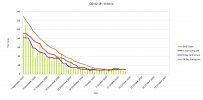The Chief Health Officer, Brett Sutton, said the challenge in Victoria was "profoundly different from equivalent case numbers in any other jurisdiction of Australia".
He said many of the people infected in Victoria's second wave faced a challenging set of social circumstances.
"Through this second wave, the 20,000 cases that occurred across Victoria settled into the hardest cohorts and populations across the state, including in metropolitan Melbourne," he said.
Professor Sutton said while the average household in Victoria had 2.5 people, many of the households at the centre of clusters were much larger.
"We're thinking that, on average, the household sizes that we're following up are twice to three times that size," he said.
"That means more workplaces exposed, and it goes on exponentially. Those workplaces have people working there who have households that are two or three times the size of an average Victorian household.
"So, the number of close contacts per household, and the number of close contacts they have, is hugely different."
He pointed to Victoria's "challenges of casualised work, of cash-in-hand, of issues of visa status, issues of language and cultural barriers".
So does NSW not have a casualised workforce, a cash in hand economy or any non-english speakers? Surely they had some large households at the centres of some clusters? NSW had over 100 cases per days for 2 weeks straight? Surely they faced the same challenges we did at that point? But somehow managed to bring the numbers down without 10 weeks of Stage 4 restrictions? Not sure you can say don't compare jurisdictions, he makes it seem like we are on another planet.
So we are either really really really unlucky or we are managing it differently and what we are doing is not as effective as in NSW. I thought I did read that we had accepted some help/advice in regards contact tracing.
Would like some further explanations on what he means when he says "Through this second wave, the 20,000 cases that occurred across Victoria settled into the hardest cohorts and populations across the state."




